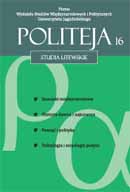Kierunki polityki pamięci na Litwie sowieckiej
Directions of the Soviet model of narrative on history of Lithuania
Author(s): Arūnas StreikusSubject(s): Politics / Political Sciences
Published by: KSIĘGARNIA AKADEMICKA Sp. z o.o.
Summary/Abstract: Soviet model of narrative on history of Lithuania was shaped during the first decade of the Soviet rule in Lithuania. Later on, elements of pre -soviet, nationalist historiography had been gradually integrated into this model; primarily those which had strong anti -occidental, anti -Christian (anti -Catholic) or anti -Polish connotations. As a result, during the soviet period historical narrative, originated from the turn of 19th and 20th century and built on the paradigm of ethnic nationalism, was consolidated in the historical imagination of the Lithuanian society. Under totalitarian control over public discourse this historical narrative became not only predominant, but also in some way purified, as no alternatives (particularly those accepting Christianity or Western culture) were allowed. Communist regime always tried to use ethnonationalistic symbols for its own legitimization. This tendency was strongest during the late 1980s crisis of the regime. Some Lithuanian Communists were advanced on this path, what made much easier their later integration into political elite of already democratic state after 1990. The soviet regime in Lithuania was much less successful in promoting its vision of Lithuanian history of the 20th century, although from mid 1950s onwards the communists tried to demonstrate the existence of authentic, communist tradition in the country. At the end of 1980s this “tradition” failed to answer new challenges in historical discourse: it could be to some degree reconciled with the condemnation of Stalinist crimes, but it gave no answer to the question of present and historical Lithuanian statehood. Changes on the symbolic map of capital – Vilnius give good insight in the main tendencies of soviet politics of memory. The city was desacralized: secularized cathedral became rather “the temple of arts”, while Vilnius University was deprived of great part of its authentic (mainly Jesuit) history. In official view (expressed in guide and scholarly publications, celebrations of anniversaries etc.) the Gate of Dawn, with the representation of the Virgin Mary in it, was no longer the main symbol of the city. For communist authorities it was rather a tower on the hill – a remnant of pagan grand duke of Lithuania Giediminas’ Castle.
Journal: Politeja - Pismo Wydziału Studiów Międzynarodowych i Politycznych Uniwersytetu Jagiellońskiego
- Issue Year: VIII/2011
- Issue No: 16
- Page Range: 281-307
- Page Count: 27
- Language: Polish

